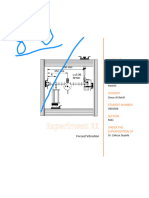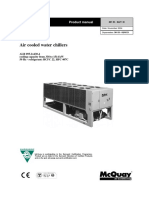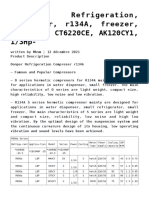F - Cdy/Dt: Instrumentation and Process Control (2150504) Sem-V - CH Chapter Name: Response of Higher Order System
Uploaded by
Bhakti MahbubaniF - Cdy/Dt: Instrumentation and Process Control (2150504) Sem-V - CH Chapter Name: Response of Higher Order System
Uploaded by
Bhakti MahbubaniInstrumentation and Process Control (2150504)
Sem- V- CH
Chapter Name: Response of Higher Order System
Damped Vibrator: Second order System
A block of mass w resting on a horizontal, frictionless table is attached to a linear spring.
A viscous damper (dashpot) is also attached to the block.
Assume that the system is free to oscillate horizontally under the influence of a forcing function F(t).
The origin of the coordinate system is taken as the right edge of the block when the spring is in
the relaxed or unstretched condition.
The block is motionless (dY/dt = 0) and
Block located at its rest position (Y = 0) before the forcing function is applied, i.e. time t = 0.
Damping is an effect that reduces the amplitude of oscillations in an oscillatory system.
This effect is linearly related to the velocity of the oscillations.
This restriction leads to a linear differential equation of motion, and a simple analytic solution.
except for mass-dominated systems.
In mechanics, damping may be realized using a dashpot.
This device uses the viscous drag of a fluid, such as oil, to provide a resistance that is related
linearly to velocity.
The damping force Fc is expressed as follows:
Fc= -cdY/dt
Prepared By: Mukesh M Mahbubani
Page 1
Instrumentation and Process Control (2150504)
Sem- V- CH
Chapter Name: Response of Higher Order System
At time zero, the block is assumed to be at rest at this origin.
Consider the block at some instant when it is to the right of Y = 0 and when it is moving toward
the right (positive direction). Under these conditions,
1. The force exerted by the spring (toward the left) of -KY
where K is a positive constant, called Hookes constant.
2. The viscous friction force (acting to the left) of -C dY/dt,
where C is a positive constant called the damping coefficient.
3. The external force F(t) (acting toward the right).
Newtons law of motion, which states that the sum of all forces acting on the mass is equal to the
rate of change of momentum (F = mass X acceleration), takes the form:
w.d2Y/dt2 = -KY-CdY/dt+ F(t)
Where
with mass w, Spring (Hooks) constant k and , viscous damper of damping coefficient
c,Where
w in kilograms, k in newtons per meter, and c is the viscous damping coefficient, given in units
of Newton seconds per meter (N s/m) or simply kilograms per second. Rearranging
equation:
the
w.d2Y/dt2 +CdY/dt +KC= F(t)
Prepared By: Mukesh M Mahbubani
Page 2
Instrumentation and Process Control (2150504)
Sem- V- CH
Chapter Name: Response of Higher Order System
Compare with standard form of second order equation:
2d2Y/dt2+ 2 dY/dt+Y(t)=X(t)
Time constant
2
: =w/K, =w/K
=C /4wK, and are positive
_______________
Take Laplace Transforms
2 s2 Y(s)+ 2 s Y(s)+Y(s)=X(s)
Transfer function is:
Y(s)/X(s)=1/(
2 s2+ 2 s +1)
Prepared By: Mukesh M Mahbubani
Page 3
You might also like
- Heat Transfer Final Exam Problem & Solutions0% (1)Heat Transfer Final Exam Problem & Solutions8 pages
- F - Cdy/Dt: Instrumentation and Process Control (2150504) Sem-V - CH Chapter Name: Response of Higher Order SystemNo ratings yetF - Cdy/Dt: Instrumentation and Process Control (2150504) Sem-V - CH Chapter Name: Response of Higher Order System3 pages
- 2nd Order Damping Vibrator Transfer FunctionNo ratings yet2nd Order Damping Vibrator Transfer Function18 pages
- Second Order Under Damped System DynamicsNo ratings yetSecond Order Under Damped System Dynamics6 pages
- Chapter 2: Introduction To Damping in Free and Forced VibrationsNo ratings yetChapter 2: Introduction To Damping in Free and Forced Vibrations10 pages
- Vibration Analysis of Discrete One and Two Degree of Freedom Systems100% (1)Vibration Analysis of Discrete One and Two Degree of Freedom Systems11 pages
- Mechanical Vibrations (10 ME 74) DampingNo ratings yetMechanical Vibrations (10 ME 74) Damping44 pages
- The Damping Mechanism of Steel-Rubber - FredyNo ratings yetThe Damping Mechanism of Steel-Rubber - Fredy8 pages
- What Is A Second-Order System?: F (T) WD Y G DT C Dy DT KYNo ratings yetWhat Is A Second-Order System?: F (T) WD Y G DT C Dy DT KY8 pages
- Supplementary Notes On First-And Second-Order System ResponseNo ratings yetSupplementary Notes On First-And Second-Order System Response20 pages
- Damped SHM: Differential Equation of Damped VibrationNo ratings yetDamped SHM: Differential Equation of Damped Vibration4 pages
- Dynamics Tutorial 11-Damped Vibrations-13p PDF100% (1)Dynamics Tutorial 11-Damped Vibrations-13p PDF13 pages
- Lecture Notes STR601 Part I - SDOF by SamehSFMehannyNo ratings yetLecture Notes STR601 Part I - SDOF by SamehSFMehanny172 pages
- Indian Institute of Technology, Kharagpur: Ocean Engineering and Naval ArchitectureNo ratings yetIndian Institute of Technology, Kharagpur: Ocean Engineering and Naval Architecture10 pages
- M2 L Vibration Acceleration MeasurementNo ratings yetM2 L Vibration Acceleration Measurement22 pages
- Force Vibration With Harmonic Excitation: Unit - IvNo ratings yetForce Vibration With Harmonic Excitation: Unit - Iv24 pages
- UNIT-1 Single-Degree-Of-Freedom Linear Systems: Part - B (Long Answer Questions)No ratings yetUNIT-1 Single-Degree-Of-Freedom Linear Systems: Part - B (Long Answer Questions)6 pages
- Free and Forced Vibration of A Single Degree of Freedom Mechanical SystemNo ratings yetFree and Forced Vibration of A Single Degree of Freedom Mechanical System8 pages
- Chapter 1 & 2 - Introduction To Vibrations and Single DOF SystemsNo ratings yetChapter 1 & 2 - Introduction To Vibrations and Single DOF Systems86 pages
- CH 03b, Viscously Damped Free Vibration of SDOFNo ratings yetCH 03b, Viscously Damped Free Vibration of SDOF25 pages
- 2.2 - Response To Free Vibrations of 1 Dof Damped SystemNo ratings yet2.2 - Response To Free Vibrations of 1 Dof Damped System5 pages
- Lesson 2. Free Vibrations With Viscous DampingNo ratings yetLesson 2. Free Vibrations With Viscous Damping8 pages
- ME421-Single Degree of Freedom System (Damped) PDFNo ratings yetME421-Single Degree of Freedom System (Damped) PDF13 pages
- List of of Nat - Int.std - Iatf - R7 - 1.4..2019No ratings yetList of of Nat - Int.std - Iatf - R7 - 1.4..20192 pages
- Form No. 25-MUSTER ROLL: (Vide Rule 103 of A.P.Factories Rules, 1950)No ratings yetForm No. 25-MUSTER ROLL: (Vide Rule 103 of A.P.Factories Rules, 1950)30 pages
- Membership Application Form: Gujarat Safety CouncilNo ratings yetMembership Application Form: Gujarat Safety Council2 pages
- Page 28 - 1: Proprietary Material. © The Mcgraw-Hill Companies, Inc. All Rights Reserved. No Part of This ManualNo ratings yetPage 28 - 1: Proprietary Material. © The Mcgraw-Hill Companies, Inc. All Rights Reserved. No Part of This Manual5 pages
- Instructions: Unrar and Install The App. Run Applied Keygen. A License File Will Be Generated. Copy It To The WWW - Downloadly.irNo ratings yetInstructions: Unrar and Install The App. Run Applied Keygen. A License File Will Be Generated. Copy It To The WWW - Downloadly.ir1 page
- Quality Oriented and ISO Approved Stainless Steel 347 Buttweld Pipe Fittings Manufacturer in IndiaNo ratings yetQuality Oriented and ISO Approved Stainless Steel 347 Buttweld Pipe Fittings Manufacturer in India4 pages
- Seismic Soil-Structure Interaction in Buildings100% (2)Seismic Soil-Structure Interaction in Buildings14 pages
- Gravitational Acceleration and Free FallNo ratings yetGravitational Acceleration and Free Fall46 pages
- Determination of The Constants of Damage ModelsNo ratings yetDetermination of The Constants of Damage Models10 pages
- Giilfi: SPE 36740 Pressure and Results Composition Effect On Wax Precipitation: Experimental Data and ModelNo ratings yetGiilfi: SPE 36740 Pressure and Results Composition Effect On Wax Precipitation: Experimental Data and Model14 pages
- Transverse Vibration of A Cantilever BeamNo ratings yetTransverse Vibration of A Cantilever Beam9 pages
- General Chemestry 1 Quarter 2 Worksheet 4 OutputNo ratings yetGeneral Chemestry 1 Quarter 2 Worksheet 4 Output3 pages
- Universal Tensile Testing Machine: Assoc. Prof. Dr. El-Hadi, AhmedNo ratings yetUniversal Tensile Testing Machine: Assoc. Prof. Dr. El-Hadi, Ahmed1 page
- 01 - C200x80 To ANY-CVR BCF Gusset PL-PL12-4M16-W6-202kN MaxNo ratings yet01 - C200x80 To ANY-CVR BCF Gusset PL-PL12-4M16-W6-202kN Max14 pages
- Donper, Refrigeration, Compressr, R134a, Freezer, LU140CY1, CT6220CE, AK120CY1, 1/3HpNo ratings yetDonper, Refrigeration, Compressr, R134a, Freezer, LU140CY1, CT6220CE, AK120CY1, 1/3Hp4 pages










































































































